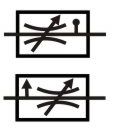1-2 What flow control valves are used for
Hydraulic flow control valves are used to control the speed at which actuators move, once directional valves have opened to set the direction. Most hydraulic machines will contain several actuators, all of which will need to move at different speeds. Flow control valves are used to control the speed of movement and allow changes to be made during setup and/or operation.
Pressure compensated flow control valves are used to give constant flow/speed on equipment, where the load changes.
1-2 How flow control valves work
In their simplest form a flow control valve is just an orifice. Fluid flow will increase until the pressure drop (p.d) across the orifice is the same as the supply pressure, less the load pressure. Supply pressure into the system must equal load pressure out of the system plus the pressure drop lost across the orifice. The pressure drop is used as the brake that controls the actuator speed.
Adjustable flow control valves contain an adjustable orifice. Higher quality valves have sharp edge orifice designs that provide more consistent flow across the working temperature range.
Pressure compensated flow control valves contain an orifice whose size changes as the pressure drop across it changes e.g. a spool element. This means the flow through the valves stays the constant under most operating conditions and the orifice size varies instead.
2 Different types of flow control valve

The main types of flow control valves are:
A fixed orifice.
An adjustable orifice.
A fixed or adjustable orifice with by-pass check to control the flow in one direction only.
A pressure compensated flow control valve with self-adjusting orifice size.
Hydraulic engineers often use the term, meter-in or meter-out flow control. In both cases, the valves are likely to be the same and it's just the way they are used that is different. With meter-in flow control we throttle the flow before the actuator. With meter-out flow control we throttle the flow after the actuator.
3 Tips for operating and maintaining (See Pro course)
Always check and beware that shutting some flow control valves can isolate the pipe run completely. Shutting valves may trap fluid into sealed lengths of pipe and therefore run the risk of excessively high pressures due to thermal expansion of the fluid. Another risk from closing the flow too much is that over-running loads may not be relieved enough, again causing excessive local pressures.
Hydraulic systems are generally designed to work at constant working temperatures, perhaps 40-50C. However, at startup, or even normal working when the local fluid temperature, next to a cylinder perhaps, may be much lower, flow control valves can operate significantly differently. These differences may lead control issues or may require the system to be warmed before operating.
0.8 mm is generally accepted as the minimum size of orifice that should be used if you want to be confident of never seeing fluid contamination issues. It may be worth checking the size your adjustable orifices are set to if you keep seeing operational issues.
Remember that changing loads can have a significant effect on fluid flow rates. Watch for load changes altering your setup, or even load and temperature changes.
Understand and check how high cylinder pressures can be caused by intensification. With meter-out flow control the pressure in the annulus side of a cylinder is likely to be around twice that of the pressure supplied to the bore. The system design should never allow this to increase above the pressure rating of the cylinder and may be why reducing valves have been added into particular cylinder lines.
3-4 Typical operating characteristic(See Pro course)
The manufacturer datasheet should provide a p.d. against flow curve.
Beware of temperature effects on performance. Some valves have better temperature compensated designs.
Consider backflow pressure drops with the bypass check options.
4 How to specify(See Pro course)
Always understand your load before you specify any valves. Write down exactly what loads your cylinder will see across the full range of working conditions, including failure modes e.g. creep, shock, extreme temperatures, maintenance etc. Calculate the worst case local pressures under all conditions.
The primary risk of meter-in is that the actuator load tries to move the cylinder quicker than the flow controller should allow, creating negative pressure and a dangerous uncontrolled load as a result. With meter-out, the load is braked by the orifice so cannot run away. The risk now is that the bore pressure creates an intensified annulus pressure that is higher than the cylinder or valves are designed to take. A good rule to easily remembered this is the saying 'if in doubt, meter out'.
Another good general rule is not to use an orifice below 0.8mm.
Within each basic valve type, you can find a wide range of performance and reliability differences. It is important to know how stable the flow needs to be across the full working flow, pressure and temperature range, before deciding which flow control valve to use.
4 Design Tips, techniques and potential issues (See Pro course)
TBC